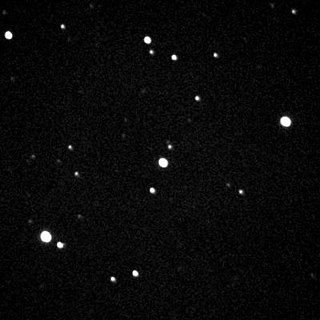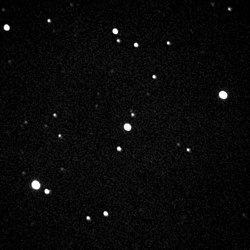WASP-1
Star in the constellation Andromeda From Wikipedia, the free encyclopedia
WASP-1 is a magnitude 12 binary star system located about 1,250 light-years away[2] in the Andromeda constellation.[7] The binary system consists of a metal-rich F-type main-sequence star, named WASP-1A, and a distant low-mass star, named WASP-1B. WASP-1A has one known transiting hot Jupiter exoplanet named WASP-1b.
| Observation data Epoch J2000 Equinox J2000 | |
|---|---|
| Constellation | Andromeda[1] |
| Right ascension | 00h 20m 40.0746s[2] |
| Declination | +31° 59′ 23.955″[2] |
| Apparent magnitude (V) | 11.68 ± 0.05[3] |
| Characteristics | |
| WASP-1A | |
| Evolutionary stage | main-sequence star |
| Spectral type | F7V[4] |
| Apparent magnitude (B) | ~12.0[5] |
| Apparent magnitude (V) | 11.68 ± 0.05[3] |
| WASP-1B | |
| Apparent magnitude (H) | 15.130 ± 0.046[6] |
| Apparent magnitude (K) | 15.116 ± 0.055[6] |
| Astrometry | |
| WASP-1A | |
| Radial velocity (Rv) | −13.90(59)[2] km/s |
| Proper motion (μ) | RA: −4.692(22) mas/yr[2] Dec.: −3.320(20) mas/yr[2] |
| Parallax (π) | 2.6108±0.0218 mas[2] |
| Distance | 1,250 ± 10 ly (383 ± 3 pc) |
| Absolute magnitude (MV) | 3.63+0.13 −0.14[3] |
| Details[3] | |
| WASP-1A | |
| Mass | 1.301+0.049 −0.047 M☉ |
| Radius | 1.515+0.052 −0.045 R☉ |
| Luminosity | 2.88+0.36 −0.30 L☉ |
| Surface gravity (log g) | 4.190+0.020 −0.022 cgs |
| Temperature | 6110±75 K |
| Metallicity [Fe/H] | 0.26±0.08 dex |
| Age | 3.0±0.6 Gyr |
| WASP-1B | |
| Mass | ~0.3[6]: 13 M☉ |
| Surface gravity (log g) | ~4.97[6]: 13 cgs |
| Temperature | ~3400[6]: 13 K |
| Position (relative to WASP-1A)[6]: 11, 13 | |
| Component | WASP-1B |
| Epoch of observation | 2013–2014 |
| Angular distance | ~4.58″ |
| Position angle | ~1.9° |
| Projected separation | 1587+160 −16 AU |
| Other designations | |
| 1SWASP J002040.07+315923.7, USNO-B1.0 1219-00005465, TOI-6014, TIC 57984377, WASP-1, TYC 2265-107-1, GSC 02265-00107, 2MASS J00204007+3159239[5] | |
| Database references | |
| SIMBAD | data |
| Exoplanet Archive | data |
Stellar companion
WASP-1A has a distant companion star, named WASP-1B. WASP-1B is a low-mass star that is around 0.3 times as massive as the Sun and has an effective temperature of about 3400 K.[6]: 24 WASP-1B is located northward of WASP-1A at an angular separation of about 4.6 arcseconds, corresponding to a projected distance of 1587 AU.[6]: 13, 15 WASP-1B was first identified in observations from 2006 and confirmed in further observations from 2012 to 2014, which showed that it shares the proper motion of WASP-1A, indicating the two stars are gravitationally bound to each other.[6]: 15
Planetary system
In 2006, an extrasolar planet was discovered by the Wide Angle Search for Planets team using the transit method.[4] The planet has a density of 0.31 to 0.40 g/cm3, making it about half as dense as Saturn, and one third as dense as water. The orbit of WASP-1b is inclined to the rotational axis of the star by 79.0+4.3
−4.5 degrees, making it a nearly "polar" orbit.[8]
Two searches for additional planets using transit-timing variations have yielded negative results.[9][10]
| Companion (in order from star) |
Mass | Semimajor axis (AU) |
Orbital period (days) |
Eccentricity | Inclination | Radius |
|---|---|---|---|---|---|---|
| b | 0.948+0.029 −0.028 MJ |
0.03958+0.00047 −0.00049 |
2.51994480±0.00000050 | <0.013 | 90.0+0.0 −2.9° |
1.514+0.052 −0.047 RJ |
See also
References
External links
Wikiwand - on
Seamless Wikipedia browsing. On steroids.

